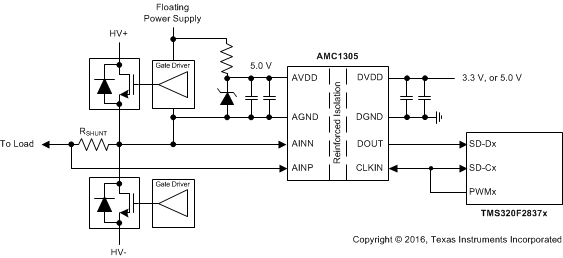ZHCSCZ0F June 2014 – March 2017 AMC1305L25 , AMC1305M05 , AMC1305M25
PRODUCTION DATA.
- 1 特性
- 2 应用
- 3 说明
- 4 修订历史记录
- 5 Device Comparison Table
- 6 Pin Configuration and Functions
-
7 Specifications
- 7.1 Absolute Maximum Ratings
- 7.2 ESD Ratings
- 7.3 Recommended Operating Conditions
- 7.4 Thermal Information
- 7.5 Power Ratings
- 7.6 Insulation Specifications
- 7.7 Safety-Related Certifications
- 7.8 Safety Limiting Values
- 7.9 Electrical Characteristics: AMC1305M05
- 7.10 Electrical Characteristics: AMC1305x25
- 7.11 Switching Characteristics
- 7.12 Insulation Characteristics Curves
- 7.13 Typical Characteristics
- 8 Detailed Description
- 9 Application and Implementation
- 10Power-Supply Recommendations
- 11Layout
- 12器件和文档支持
- 13机械、封装和可订购信息
1 特性
- 针对基于分流电阻的电流测量进行优化的引脚兼容系列:
-
出色的直流性能,支持系统级高精度感测:
- 偏移误差:±50µV 或 ±150µV(最大值)
- 偏移漂移:1.3µV/°C(最大值)
- 增益误差:±0.3%(最大值)
- 增益漂移:±40ppm/°C(最大值)
- 安全相关认证:
- 7000 VPK 增强型隔离,符合 DIN V VDE V 0884-10 (VDE V 0884-10): 2006-12 标准
- 符合 UL 1577 标准且长达 1 分钟的 5000 VRMS 隔离
- CAN/CSA No. 5A 组件接受服务通知、IEC 60950-1 和 IEC 60065 终端设备标准
- 瞬态抗扰度:15kV/µs(最小值)
- 高电磁场抗扰度
(请参见应用手册 SLLA181A) - 外部 5MHz 至 20MHz 时钟输入
可更加轻松地实现系统级同步 - 可在扩展工业温度范围内运行
2 应用
- 基于分流电阻的电流感测用于下列应用:
- 工业电机驱动
- 光电逆变器
- 不间断电源
- 隔离电压感测
3 说明
AMC1305 器件是一款高精度 Δ-Σ (ΔΣ) 调制器,通过磁场抗扰度较高的电容式双隔离栅隔离输出与输入电路。根据 DIN V VDE V 0884-10、UL1577 和 CSA 标准,该隔离栅经认证可提供高达 7000 V峰值 的增强型隔离。当与隔离电源配合使用时,该器件可防止共模高电压线路上的噪声电流进入本地系统接地,从而干扰或损害低电压电路。
AMC1305 针对直接连接分流电阻器或其它低电压等级信号源进行了优化,同时具有出色的直流和交流性能。分流电阻器通常用于感测电机驱动、绿色能源发电系统或其它工业应用中的 电流。通过使用适当的数字滤波器(即,集成于 TMS320F2837x)来抽取位流,该器件可在 78kSPS 数据速率下实现 85dB (13.8 ENOB) 动态范围的 16 位分辨率。
在高侧,调制器由 5V (AVDD) 标称电压供电,而隔离数字接口则由 3.3V 或 5V 电源 (DVDD) 供电。
AMC1305 采用宽体小外形尺寸集成电路 (SOIC)-16 (DW) 封装,工作温度范围为 –40°C 至 +125°C。
器件信息(1)
| 器件型号 | 封装 | 封装尺寸(标称值) |
|---|---|---|
| AMC1305x | SOIC (16) | 10.30mm x 7.50mm |
- 如需了解所有可用封装,请参见数据表末尾的可订购产品附录。
